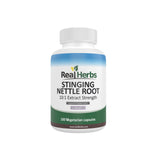Stinging Nettle Root and Joint Pain: Natural Pain Relief Mechanism
Introduction
Joint pain is a common ailment that can significantly impact one's quality of life. Whether caused by arthritis, inflammation, or other factors, finding effective and natural solutions is a priority for many individuals. In the quest for natural pain relief mechanisms, stinging nettle root has emerged as a promising remedy. In this article, we will explore the potential of stinging nettle root in alleviating joint pain, examining its historical uses, active compounds, and scientific evidence supporting its efficacy.
Understanding Joint Pain
Before delving into the specifics of stinging nettle root, it's essential to understand the nature of joint pain. Joint pain can arise from various conditions, including arthritis, inflammation, and injuries. Its prevalence makes it a significant health concern, prompting individuals to seek alternative and complementary approaches to manage discomfort.
Overview of Stinging Nettle Root:
Stinging nettle (Urtica dioica) is a perennial plant known for its stinging hairs that can cause skin irritation upon contact. However, beyond its reputation as a nuisance, stinging nettle has a long history of use in traditional medicine. The plant is valued for its versatile properties and has been employed to address a range of health issues, including joint pain. Let's explore the potential benefits of stinging nettle root and how it may offer a natural solution for those seeking relief from joint discomfort.
Active Compounds in Stinging Nettle Root
Stinging nettle root contains a variety of bioactive compounds that are believed to contribute to its potential therapeutic effects. These include lectins, phenols, and lignans, each playing a role in the plant's anti-inflammatory and antioxidant properties. These compounds have captured the interest of researchers exploring natural alternatives for managing joint pain.
Research and Studies
Scientific studies have investigated the effectiveness of stinging nettle root in addressing joint pain. A notable study published demonstrated a significant reduction in inflammatory markers among participants who consumed stinging nettle supplements regularly. Other trials have explored its impact on specific types of arthritis, with promising results indicating its potential as a complementary therapy.
Mechanism of Action
The mechanism by which stinging nettle root alleviates joint pain is multifaceted. Its anti-inflammatory properties may help modulate the immune response, reducing inflammation in the joints. Additionally, certain compounds in stinging nettle may act as natural analgesics, providing relief from pain associated with various joint conditions.
Benefits of Stinging Nettle Root for Joint Pain
The reported benefits of stinging nettle root for joint pain are diverse. Users have reported reduced pain, improved joint function, and an overall enhancement in their quality of life. These positive outcomes align with the findings of clinical studies, further supporting the potential of stinging nettle as a natural remedy for joint discomfort.
Conclusion
In conclusion, stinging nettle root presents itself as a promising natural remedy for those seeking relief from joint pain. With its historical uses, active compounds, and supported by scientific studies, stinging nettle offers a potential alternative or complementary approach to conventional treatments. As with any health-related decisions, individuals are encouraged to make informed choices, considering their unique circumstances and consulting with healthcare professionals when necessary.












